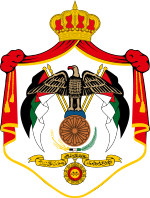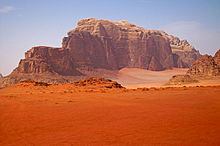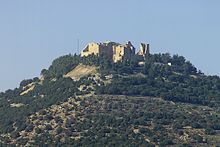Ministry of Tourism and Antiquities (Jordan)
This article needs additional citations for verification. (September 2024) |
| وزارة السياحة والآثار وزارة السياحة والآثار Wizarat Al-Siyaha wal-Athar | |
 | |
| Agency overview | |
|---|---|
| Jurisdiction | Government of Jordan |
| Headquarters | Amman, Jordan |
| Agency executive |
|
| Child agency |
|
| Website | mota.gov.jo |
The Ministry of Tourism and Antiquities (Arabic: وزارة السياحة والآثار) is a governmental body in Jordan responsible for the development, promotion, and preservation of the country's tourism and antiquities sectors. Established in 1967, the Ministry plays a critical role in managing Jordan's cultural heritage and promoting it as a global tourist destination.[1] It is located at the third circle in Jabal Amman.
The Ministry is responsible for licensing travel agencies and tourism associations in Jordan.[2] Tourism is a key pillar of the Jordanian economy, given the country's abundance of archaeological and natural sites.[3] The Ministry of Tourism in Jordan strives to improve the quality of the tourism product to attract the largest number of visitors and tourists from Jordan and around the world. Several regulations and laws have been enacted to serve the tourism sector.
History
[edit]The Ministry of Tourism and Antiquities was established in response to the growing importance of tourism as a key economic sector in Jordan. It was established in 1967. The Ministry's creation aimed to organize and manage the tourism industry, ensuring that it contributed effectively to the nation's economy while preserving the country's historical and cultural sites.
The Ministry has undergone several name changes over the years. In 1967, 57 years ago, it was known as the Ministry of Tourism (Arabic: وزارة السياحة, romanized: Wizarat Al-Siyaha). By 1981, 43 years ago, it was renamed as the Ministry of Tourism, Antiquities (Arabic: وزارة السياحة والآثار والثقافة والشباب, romanized: Wizarat Al-Siyaha wal-Athar wal-Thaqafa wal-Shabab). A year later, in 1982, 42 years ago, it became the Ministry of Industry and Trade (Arabic: وزارة الصناعة والتجارة, romanized: Wizarat Al-Sina'a wal-Tijara). In 1985, 39 years ago, it was rebranded as the Ministry of Information, Culture, and Tourism (Arabic: وزارة الإعلام والثقافة والسياحة, romanized: Wizarat Al-I'lam wal-Thaqafa wal-Siyaha). Then, in 1988, 36 years ago, it returned to being the Ministry of Tourism (Arabic: وزارة السياحة, romanized: Wizarat Al-Siyaha) before being changed again later that same year to the Ministry of Information, Culture, Tourism, and Antiquities (Arabic: وزارة الإعلام والثقافة والسياحة والآثار, romanized: Wizarat Al-I'lam wal-Thaqafa wal-Siyaha wal-Athar). Finally, in 1989, 35 years ago, it settled on the name the Ministry of Tourism and Antiquities (Arabic: وزارة السياحة والآثار, romanized: Wizarat Al-Siyaha wal-Athar).[4]
In 1953, the first office responsible for tourism in the Kingdom was established in Jerusalem, which was then the spiritual and touristic capital of Jordan. Initially, this office was managed by a small team focused on providing services to pilgrims visiting the city. However, as the number of tourists and pilgrims increased, the office was elevated to a department directly accountable to the Prime Minister. By September of the same year, the headquarters were moved to Amman, while a small branch office remained in Jerusalem, with the department maintaining its independence and reporting directly to the Prime Minister.[4]
The government, recognizing the need for enhanced tourism services, established the first rest area at the Ar-Ramtha border point in 1956 with support from the International Development Agency. This move was part of a broader vision to improve the tourism administration, prompting Jordan to seek international expertise to evaluate and develop the sector. By 1960, the tourism department had transformed into an independent entity under the Ministry of National Economy. This shift was solidified by the introduction of Law No. 17, which established a Tourism Authority Board chaired by the Prime Minister and included key officials from various ministries and sectors. In 1964, the Tourism Authority was integrated into the Ministry of Tourism while retaining its independent status.[4]
In the following years, the tourism sector underwent several administrative changes. In 1967, a royal decree elevated the Tourism Authority to a ministry, incorporating the Department of Antiquities. The sector continued to evolve, with new laws in 1975 and 1988 aiming to enhance private sector participation and expand the authority's responsibilities. However, following the war in 1988, tourism reverted to an independent authority under various ministries before finally, in 1989, being reorganized into the Ministry of Tourism and Antiquities, which included the Department of Antiquities.[4]
Mission and responsibilities
[edit]The Ministry's primary objectives center around several key areas. First, it focuses on promoting tourism by marketing Jordan as a prime destination for both cultural and recreational tourism. This involves highlighting the country's rich historical sites, diverse natural landscapes, and vibrant cultural experiences to attract visitors from around the world. Another crucial objective is the preservation of antiquities, where the Ministry is dedicated to safeguarding Jordan's archaeological sites and artifacts. This ensures that these invaluable pieces of history are protected and maintained for future generations.[2]
In addition to these efforts, the Ministry is committed to sustainable tourism development. This involves encouraging practices that balance the economic benefits of tourism with the need to preserve the environment and cultural heritage. Finally, the Ministry promotes cultural exchange programs that aim to enhance understanding between Jordan and other countries through tourism, fostering greater global connections and cultural appreciation.[3]
The Ministry of Tourism and Antiquities has several key responsibilities that support its mission. One of the primary responsibilities is the management of archaeological sites. This includes overseeing the excavation, restoration, and maintenance of Jordan's many historical sites, such as Petra, Jerash, and the Dead Sea, which are recognized around the world for their significance. The Ministry is also responsible for the development of tourism infrastructure, which involves creating and improving facilities such as hotels, resorts, and transportation networks to better accommodate tourists.[2]
In terms of industry standards, the Ministry establishes regulations and standards for the tourism sector to ensure that visitors receive high-quality services and have positive experiences during their stay in Jordan. Additionally, the Ministry engages in international cooperation, collaborating with global organizations, other countries, and the private sector. These partnerships help to enhance Jordan's tourism offerings and contribute to the preservation of its rich heritage.[3]
Projects
[edit]The Ministry has launched several major projects and initiatives to further its objectives. One such initiative is the Jordan Tourism Strategy, a long-term plan designed to increase the number of tourists visiting the country, improve the quality of tourism services, and maximize the economic impact of the tourism sector. Another significant project is the Cultural Heritage Protection Program, which focuses on preserving and promoting Jordan's cultural heritage through various preservation projects and educational initiatives.[5]
To boost international awareness of Jordan's unique attractions, the Ministry has also developed tourism promotion campaigns. These global marketing efforts, such as the "Kingdom of Time" campaign, are designed to showcase the historical and cultural richness of Jordan, positioning it as a must-visit destination for travelers from around the world.[6]
Notable archaeological sites
[edit]
Jordan is home to a number of significant archaeological sites under the Ministry's care, including:[7]
- Petra: Petra, often referred to as the "Rose City" due to the color of the stone from which it is carved, is one of the most famous archaeological sites in the world. Located in southern Jordan, Petra was the capital of the Nabataean Kingdom and is renowned for its intricate rock-cut architecture and advanced water management system. The city's most iconic structure, the Treasury (Al-Khazneh), is a magnificent facade carved directly into the sandstone cliffs. Petra was rediscovered in 1812 by Swiss explorer Johann Ludwig Burckhardt and has since been recognized as a UNESCO World Heritage Site. It was also named one of the New Seven Wonders of the World in 2007. The site attracts hundreds of thousands of tourists annually, making it a cornerstone of Jordan's tourism industry.

- Jerash: Jerash, located north of Amman, is one of the best-preserved Roman provincial towns in the world. The city, known as Gerasa during the Roman era, showcases the grandeur of Roman urbanism with its colonnaded streets, temples, theaters, and public squares. Among the most notable structures in Jerash are the Temple of Artemis, the Oval Plaza, and the Jerash Hippodrome, where reenactments of Roman chariot races still take place. The city hosts the annual Jerash Festival of Culture and Arts, which draws performers and audiences from across the globe. Jerash provides a vivid glimpse into the life of a Roman city and remains one of Jordan's top tourist destinations.

- The Dead Sea: The Dead Sea, located at the lowest point on Earth's surface, is a unique natural wonder renowned for its hyper-saline waters and therapeutic mud. The high salt content of the water allows visitors to float effortlessly, making it a popular destination for those seeking relaxation and health benefits. The area surrounding the Dead Sea is also rich in historical and archaeological significance, with sites like the ancient fortress of Masada and the biblical cities of Sodom and Gomorrah nearby. The Dead Sea region is a vital part of Jordan's tourism offering, attracting visitors for both its natural beauty and its reputation as a center for wellness tourism.
- Umm Qais (Gadara): Umm Qais, anciently known as Gadara, is located in the north of Jordan and offers stunning views of the Sea of Galilee, the Golan Heights, and the Yarmouk River. Gadara was one of the cities of the Decapolis, a group of ten cities on the eastern frontier of the Roman Empire. The site features impressive Greco-Roman ruins, including a theater, colonnaded streets, and mausoleums. Umm Qais is also notable for its blend of cultures, where Roman, Byzantine, and Islamic influences converge. The site is a testament to Jordan's rich history and is a must-visit for those interested in exploring the layers of civilizations that have existed in the region.
- Al-Maghtas (Bethany Beyond the Jordan): Al-Maghtas, also known as Bethany Beyond the Jordan, is a site of great religious significance as it is believed to be the location where Jesus Christ was baptized by John the Baptist. Located on the eastern bank of the Jordan River, Al-Maghtas is a UNESCO World Heritage Site and is visited by thousands of pilgrims each year. The site includes remnants of ancient churches, baptismal pools, and other structures dating back to the Roman and Byzantine periods. Al-Maghtas is not only an important site for Christians but also a symbol of Jordan's deep spiritual heritage and its role in the history of the region's monotheistic religions.

Ajloun Castle in 2009 - Ajloun Castle: Ajloun Castle, also known as Qal'at Ar-Rabad, is a 12th-century fortress built by the Ayyubid dynasty to protect the region against Crusader invasions. Located on a hilltop in the Ajloun region, the castle offers panoramic views of the Jordan Valley and is surrounded by lush forests. The strategic location of Ajloun Castle made it a key military and administrative center during the medieval period. The fortress features well-preserved towers, chambers, and a museum that displays artifacts from various periods of Jordanian history. Ajloun Castle is a prime example of Islamic military architecture and remains a popular tourist destination for those interested in history and architecture.
Challenges
[edit]
The Ministry faces several significant challenges in its efforts to promote and manage tourism in Jordan. One of the foremost challenges is the preservation of historical sites. As tourism continues to grow, there is an ongoing need to balance this growth with the protection and conservation of Jordan's rich archaeological and cultural heritage. The Ministry must ensure that these sites are not damaged or degraded by the increasing number of visitors, requiring careful planning and management to maintain their integrity for future generations.[8]
Another challenge is political instability in the region, which can have a profound impact on tourism numbers. Fluctuations in regional stability often influence travelers' decisions, making it essential for the Ministry to develop adaptive strategies that can help maintain and even grow the tourism sector during uncertain times. This involves not only promoting Jordan as a safe and attractive destination but also working closely with international partners to mitigate the effects of political unrest.
Additionally, the Ministry must address the effects of climate change on Jordan's natural and archaeological sites. Many of these sites are particularly vulnerable to environmental shifts, such as extreme weather events and changes in temperature and precipitation patterns. The Ministry is tasked with implementing measures to protect these valuable resources from the impacts of climate change, ensuring their preservation in the face of evolving environmental challenges.
See also
[edit]References
[edit]- ^ "الصفحة الرئيسية - وزارة السياحة والاثار". www.mota.gov.jo. Retrieved 2024-08-23.
- ^ a b c "مهام الوزارة". 2018-06-15. Archived from the original on 2018-06-15. Retrieved 2024-08-23.
- ^ a b c "الرؤية". 2017-07-26. Archived from the original on 2017-07-26. Retrieved 2024-08-23.
- ^ a b c d "نبذة عن الوزارة - وزارة السياحة والاثار". www.mota.gov.jo. Retrieved 2024-08-24.
- ^ "المشاريع و المبادرات - وزارة السياحة والاثار". www.mota.gov.jo. Retrieved 2024-08-23.
- ^ "Tourism promotion campaign launched in Europe | Visit Jordan". international.visitjordan.com. Retrieved 2024-08-23.
- ^ "اماكن تستحق الزيارة". 2017-07-29. Archived from the original on 2017-07-29. Retrieved 2024-08-23.
- ^ "Jordan's tourism sector faces lingering hindrances to full potential, say stakeholders". Jordan Times. 2023-05-22. Retrieved 2024-08-23.

